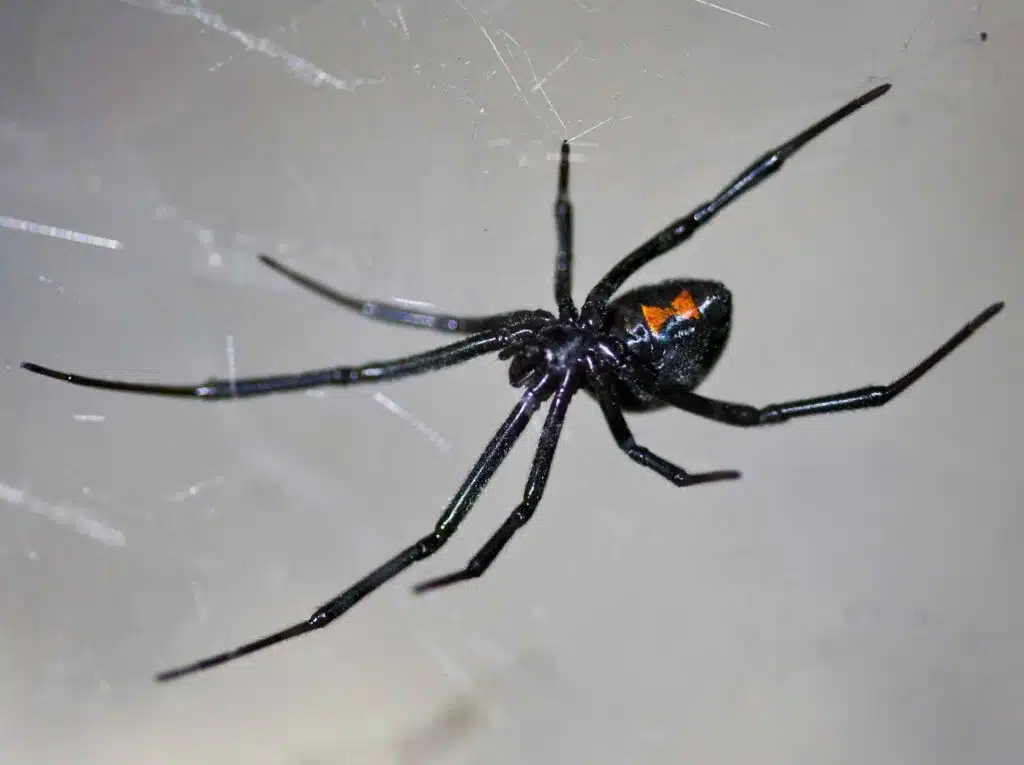Spider bite on Dog: More than 50,000 species of spiders have been found worldwide, with only a small percentage considered dangerous (although deadly to dogs and humans).
How dangerous is the spider when considering dog anatomy versus human anatomy?
In general, spider venom is designed to be effective against small animals such as cats or dogs.
Two groups of spiders that cause the most clinically significant spider bites are Widow spiders (including Latrodectus spp., Including the black widow spider) and solitary spiders (including Loxocells spp., Brown Recluse).
Black Widow spiders
Black Widow spiders are found in tropical and subtropical regions around the world. There are five species of Latrodectus found in the United States, the most common being the Black Widow Spider.
Black widow spiders are one of the two venomous spider species in North America that can pose a serious threat to dogs. The female black widow is the more dangerous of the two, as she is larger and has more potent venom.

Black widows have shiny black body with a distinctive red hourglass marking on the underside of their abdomen. Symptoms of a black widow spider bite in dogs can appear within 30 minutes and may include vomiting, drooling, lethargy, rapid weight loss, muscle spasms, pain, trouble breathing, elevated heart rate and blood pressure, and even paralysis.
These bites require immediate veterinary attention, as the venom can be life-threatening, especially for smaller dogs. Thankfully, around 15% of black widow bites are considered “dry” and do not inject venom.
Brown recluse spiders
The other venomous spider species that most pet owners should be aware of is the brown recluse. Brown recluse spiders have a distinctive violin-shaped marking on their back, with the “neck” of the violin pointing away from their head. They typically have a plain tan or brown body and legs, and their bodies are no larger than half an inch.
Unlike black widow bites, brown recluse bites may not be immediately painful or show obvious signs. However, within 2-8 hours, the venom will start to kill surrounding tissue, causing a characteristic bull’s-eye pattern with a white or purple center surrounded by reddened skin. Other symptoms can include anemia, bloody urine, fever, vomiting, lethargy, and organ damage.
Brown recluse bites also require prompt veterinary treatment, as the venom can be very dangerous. The Chilean recluse spider is a relative of the brown recluse that is even more venomous, though less common. Its bite symptoms and treatment are similar to the brown recluse.
Other spiders are deadly to dogs and can successfully kill your pet. There are four particularly dangerous spiders in the United States that appear in one way or another: black widow, brown widow, brown recluse, and tarantulas.
What are the clinical signs of spider bites?
The clinical signs of spider bites vary depending on the species that distributed the bite.
Patients who have been bitten by a black widow spider may develop clinical signs within 8 hours. About 15% of black widow bites are ‘dry bites’, in which enzymation does not occur, and in 85% of bites, there is some modification.
Although most of the bites lead to envenomation, the number of patients who develop significant clinical signs is low. Initially, a black widow’s bite is moderately painful and mildly red or swollen.
In the coming hours, more severe symptoms may occur. These signs include muscle aches and cramps, vomiting, diarrhea, chills, and anxiety.
Affected dogs and cats also develop muscle stiffness and may feel pain in their abdomen (belly).
Brown solitary bite, by contrast, is often not painful during the bite. Small amounts of stinging or redness may be noticed and blistering may occur within 2-8 hours.
The blister often develops as a ‘bulls-eye lesion’, with a red circle around the pale area reaching the dark area of tissue death.
Fever and lethargy may be observed in the days following the bite, and in rare cases, renal and coagulation abnormalities may occur;
However, the brown recluse bite is primarily caused by a local reaction and localized tissue damage.
How does spider venom produce these effects?
The effects of black widow and brown spider bites vary significantly due to differences in the venom of these two types of spiders.
Black widow spider venom contains neurotoxins. This substance causes massive stimulation of neurons (cells in the nervous system), which leads to muscle tremors and other effects found in the black widow.
Also Read: Best Online Dog Training Courses for 2021 during Covid Pandemic
Brown recluse spider venom, by contrast, contains many substances that induce local tissue effects. The first part of Brown Ricklus venom contains a substance called sphingomyelinase D, which prevents blood from clotting at the site of the bite. Excess toxins are injected into the bite victim, all of which contribute to local inflammation and tissue necrosis (death).
5 ways to deal with spider bite on dog (at home)
Each spider and spider bite is different, allowing different actions to be taken. Depending on the severity of the bite, the correct course of action depends on whether the bite can be resolved at home or requires a visit to a veterinarian. There are five main courses to deal with spider bites:
1. First aid
Then apply a cold compress on the affected area. For the next two days, repeat as needed. Pain medications are not required if the dog does not show severe symptoms.
But if required use the below-given pain medication for your dog.
Most spider bites do not any require medical intervention or extensive treatment and can be treated with a step-by-step method at home. First, wash the spider bite area with soap and water or dog shampoo.
2. Potato poultices
A spider bite on a simple potato dog can help reduce inflammation and reaction. Create a potato peel by scraping the peeled potatoes and wrapping the slices in a thin cloth. Using a rubber band, secure the potato slices inside the cloth and apply poultices to the spider bite until the potato dries. Repeat as needed, making sure to clean the bite before trying to re-use the powder.
3. Baking soda paste
Another costly solution is to show that baking soda paste can cure spider bites. Make a paste of baking soda and water to improve spider bite properties and apply several times a day. For a thick paste, use three parts baking soda and one part water.
4. Aloe vera
Aloe vera, known for its skin-reviving properties, is another option for treating spider bites. It also reduces inflammation and itching. Do not use the gel directly from the aloe plant, as the dog may eat it and become ill. Search for a dog-friendly labeled product such as aloe vera mist or ointment containing aloe. This is a good choice from Farnam. Aloe vera can be applied several times a day until the spider bite improves or heals.
5. Vet visit
If the spider bite on the dog does not heal itself or shows advanced symptoms, it is time to visit the vet to determine the next course of action.
Some spiders have venom that needs to be treated with antivenin.
Always try to catch the spider that has bitten the dog, take a picture or keep the spider in a safe place so that it can be adequately spotted when a visit to the vet is needed.
Conclusion
Most of the spider bites are not too dangerous to dogs or are close to a place where you do not need to worry, some are certainly very dangerous and deadly to dogs.
Never assume that the dog has passed the dangerous period until the spider bite has completely disappeared and the dog has no symptoms.
Emergencies can arise and they need to be taken care of. When a bite is left untreated, it can lead to skin death and ulceration, slow healing large wounds, and infection, leading to seizures, blood disorders, kidney failure and death.

